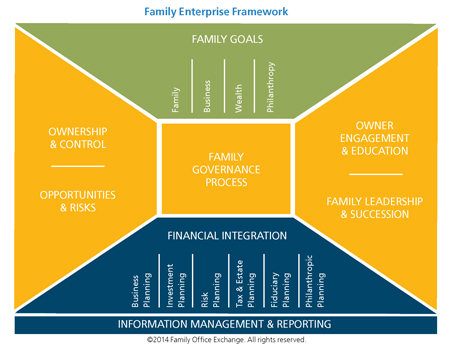Operating as a Family Enterprise – Integration in Practice

Every family enterprise needs a framework for holding together the disparate parts of the family activities, and a process for managing the elements in the framework. An integrated model of the Family Enterprise encompasses the family’s capital goals (in green), family governance and leadership issues (in gold), and the coordination of financial alternatives and solutions (in blue). The goals are the backbone from which everything else takes direction. In successful multi-generational families, these goals are revisited with regular frequency to ensure that they continue to reflect the interests of the family’s current stakeholders.
At the core of the framework are the key strategies and processes that provide shape, structure, and support: ownership and control, evaluation of opportunities and risks, owner engagement and education, family leadership and succession, and at the center of it all, the family governance process. These elements are viewed by the most successful family enterprises as the key to support successive generations, and they should be the greatest area of focus for the family.
To measure long-term success, family oversight and regular assessment of performance is essential. The most successful family enterprises take a broad view, seeing the framework as providing the dynamic power to translate the family’s goals into action through business planning, investment planning, risk planning, tax and estate planning, and philanthropic planning – all supported by state-of-the-art information management and reporting systems.
While the family must stay abreast of the workings of all aspects of the Family Enterprise Framework, some areas require greater focus than others. Furthermore, the focus may need to shift depending on the life stage of the family and the current challenges it faces. As many families have learned, the goals area of the framework cannot be delegated by family members to outside advisors. As an example, the family governance process is integral to building an optimal family enterprise system, and family members must own and oversee this process.
